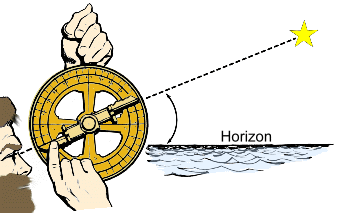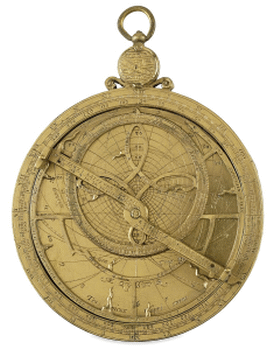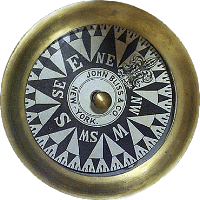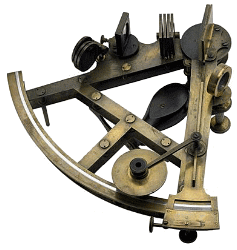  Astrolabes were astronomical calculating devices that did everything from tell the time to map the stars. The astrolabe, which was a precursor to the sextant, was effective for determining latitude and other information on land or calm seas.
Astrolabes were astronomical calculating devices that did everything from tell the time to map the stars. The astrolabe, which was a precursor to the sextant, was effective for determining latitude and other information on land or calm seas. Because it was less reliable on the heaving deck of a ship in rough seas, the mariner's astrolabe (right) was developed to solve that problem. This remarkably versatile tool was used for over a thousand years in European and Islamic cultures, before being quietly overshadowed by newer technologies.  As a star chart and physical model of the heavenly bodies, the astrolabe's functions also included an inclinometer for measuring the elevation angle of astronomical bodies, and an analog calculation device for working out several kinds of problems in astronomy. It was a metal disc with wires, cutouts, and perforations that allowed a user to calculate star and planet positions precisely. It could be used to identify stars or planets, to determine local latitude, or to triangulate. As a star chart and physical model of the heavenly bodies, the astrolabe's functions also included an inclinometer for measuring the elevation angle of astronomical bodies, and an analog calculation device for working out several kinds of problems in astronomy. It was a metal disc with wires, cutouts, and perforations that allowed a user to calculate star and planet positions precisely. It could be used to identify stars or planets, to determine local latitude, or to triangulate. These multi-use tools consisted of a circular stack of sliding features all embedded within a disk called a 'mater'. A round plate containing a two-dimensional projection of the Earth's latitudinal lines sat within the mater and, over that plate, another circular feature called the 'rete' contained the locations of certain well-known stars in the sky. Over that, a straight rule pivoted around to line up with time measurements along the edge. On the back of the whole thing, a pivotable sighting device helped find the altitude of a star, often the starting point of a calculation. Because what's in the sky changes with latitude, astrolabes commonly came with a series of plates associated with different latitudes of large cities. And though they could have been made out of a variety of materials, the majority that remain intact today are made of brass, and are very ornate. The first astrolabe may have been invented by Hipparchus in about 150 B.C. However, there is strong evidence that the astrolabe got its start around the time of Ptolemy, a famous Greek astronomer who lived in the Roman Empire during the 2nd century AD. Ptolemy left records suggesting he used a three-dimensional instrument similar to the astrolabe to make calculations. Science in those days was mostly done by individuals who were well off, and who were doing things because they were just interested in them. The astrolabe's components helped inspire modern techniques., including new methods of mathematics and the early development of astronomy. An astrolabe would have been one of the tools that Christopher Columbus would have used when exploring the New World, along with a quadrant and various tables and almanacs. Portuguese explorers who were accustomed to using the North Star, or Polaris, to find their way, also used this tool when they sailed close enough to the equator that Polaris was no longer visible. In 1488 Bartolomeu Dias used an astrolabe to find the latitude of the Cape of Good Hope in the southern hemisphere.  In 1574 the instrument was greatly improved by Humphrey Cole. His astrolabe was the finest example of the instrument ever constructed. It was made of brass and the circle was half a metre in diameter. On the face was a star map, a removable plate with lines of altitude and hours. With the help of a table of the sun's declination this instrument could be used at sea to determine latitude during the day. In 1574 the instrument was greatly improved by Humphrey Cole. His astrolabe was the finest example of the instrument ever constructed. It was made of brass and the circle was half a metre in diameter. On the face was a star map, a removable plate with lines of altitude and hours. With the help of a table of the sun's declination this instrument could be used at sea to determine latitude during the day.By the 18th century, the astrolabe began to disappear. Other devices, like modern clocks, better compasses, sextants for precise navigation, and much later modern computers, took its place. 
 Mariner's compass and sextant |